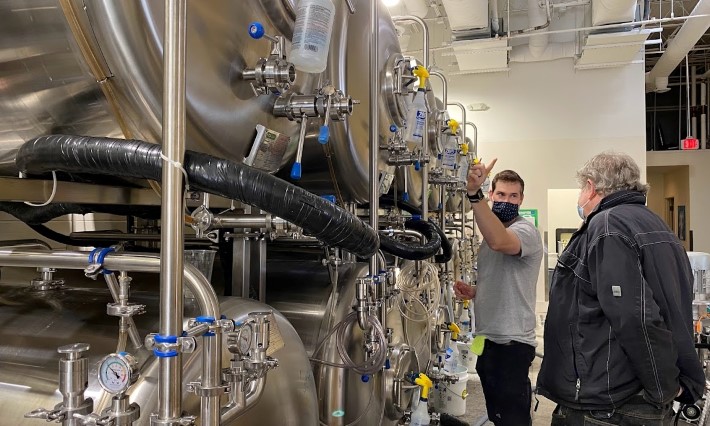
Remember when Lew Bryson started The Session Beer Project in 2007? He originally set the cap for session beers at 5.5% ABV, then lowered it to 4.5%. And finding truly flavorful beers that met the standard was not particularly easy.
Now it seems as if 2.5% ABV is the new 4.5%. Such beers may be labeled “low alcohol.” “Building quality low-alcohol beer is a balancing act,” Josh Bernstein writes in The New York Times. Among others, Bernstein talked with Todd DiMatteo, brewer and co-founder at Good Word Brewing & Public House in Duluth, Georgia. He also mentioned Little Beer, a festival Good Word will host in April.
The first Little Beer, held last May, was the first and last festival I have attended since Covid arrived in the United States. The 2022 lineup is spectacular in a different way than the also spectacular lineup for Side Project Invitational the same day. I plan to write more about that later.
A bit of disclosure. DiMatteo and I are friends. I once hung out and helped brew a 3.5% ABV beer at Good Word that we called Lunar Gravity. (One Untappd contributor gave it 4 1/2 stars and wrote “Definitely good for a lager.”) Last week, among the reasons I was back in Georgia was because Ron Pattinson came to the U.S. to drink a beer DiMatteo brewed from a recipe Pattinson wanted to taste.
The beer is called No Wooden Shoes and is a 3.5% ABV Dutch-style Donkerbier. About four dozen Georgia brewers showed up at Good Word on Thursday to listen to Pattinson talk about low-gravity English beers. I sat beside him and answered a few questions about hops, but I know why they braved Atlanta traffic to get to Duluth.
On Wednesday, Pattinson and I visited a few Georgia breweries. The photo at the top was taken at Elsewhere Brewing and that’s brewer Josh Watterson with him in front of 12 horizontal tanks (six fermentation tanks, six serving vessels).
Now, back to regular programming.
COMPARE & CONTRAST
“Selling out” revisited. This is quite a sentence: “At its zenith, craft beer might have achieved something close to that kind of (beer-centric) social, civic saturation, but those days are in the rearview now.” Perhaps this overstates the import of craft beer in the decade of your choice and at the same time understates its ongoing impact within smaller communities.
Bell’s Brewery has 1,300 employees. What’s it going to be like to work there in five years and what will Eccentric Day be like? I’m willing to wait and see. What will it be like at New Belgium Brewing, which is now “integrating” with Bell’s? There is a standard to live up to (see the next section and Brian Callahan).
[Insert headline]. Try as I may I could not come up with a few words to summarize this story that doesn’t come off churlish. The Brewers Association independent craft brewer seal has caught plenty of flack since it was introduced in 2017, but it helped make “indie brewer” part of our vocabulary. I expect that the founders of Indie Brewing are good neighbors and don’t deserve a headline that reads, “Indie Brewing Is Dead.”
‘WOW, I THINK I COULD DO THIS’
He started as a volunteer, bottling beer. He was the company’s first employee owner. He finished happily working on the grounds crew. A very New Belgiumesque story.
A FORGOTTEN RUNT
An exploration of sour and our evolutionary past. Or why you wouldn’t give a tomato or lemon to a sheep.
BUSINESS PAGES
“It’s been years since a new beer ad reached pop culture status.” I can live with that.
Discarding gender roles. “There is no more important narrative in the last century of U.S. alcohol than the rise of women drinkers.”
Related: In The New Brewer (available in print and to Brewers Association members online) “Beer’s Tenacious Gender Gap” concludes “Someday we may look back and see this era as the time when our culture tools its first baby steps away from the whole idea of categorizing human traits as ‘masculine’ or ‘feminine.’”
When Fuller’s was funky. Ah, yes, the 70s.
I’m confused. The subhead on this story states, “As baby boomers retire and buy less wine, producers need new ways to tempt a White Claw generation back from other alcoholic drinks.” But within there is this quote: “A brand’s social values are increasingly connected to a consumer’s decision to purchase particular products, including wine.” I would like to see the memo revealing White Claw’s social values.
HOP MAN
Why was I not given this option when answering census questions?
New (to me) census occupational category: Hop Man! In the 1910 California population census. ? cc @brewingarchives @StanHieronymus @LizGaribayChi pic.twitter.com/gX8DkuLw0T
— Jennifer Jordan (@ediblememory) February 10, 2022